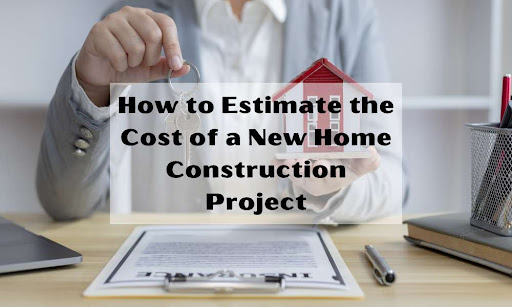
Building a new home is a significant investment that requires careful planning and budgeting. Estimating the cost of a new home construction project can be a daunting task, as there are many factors to consider, including materials, labor, permits, and unforeseen expenses. Without a realistic budget, a construction project can quickly spiral out of control, causing stress and financial strain. To ensure that your new home construction project stays within budget, it is essential to have a solid understanding of the cost estimation process.
In this blog post, we will explore some of the key factors to consider when estimating the cost of a new home construction project, including tips and tricks to help you stay within budget and avoid costly mistakes. Whether you are a first-time homeowner or a seasoned builder, this guide will provide valuable insights and practical advice to help you achieve your dream home without breaking the bank.
Assessing the Site
Assessing the site is a critical step in any construction project. It involves evaluating the location, site conditions, and cost of site preparation. This process is essential to ensure that the construction project is feasible, safe, and cost-effective.
A. Determining the location
The first step in assessing a site is determining the location. Location is a crucial factor that can affect the success of the project. The site’s proximity to resources, transportation, and potential customers can determine the project’s viability. The location should also be accessible, secure, and have adequate space for the project.
The site’s topography is another crucial factor to consider. The slope and elevation of the land can affect the project’s foundation and drainage. It is essential to evaluate the soil condition, which can determine the suitability of the site for the proposed project.
B. Evaluating the site conditions
After determining the location, the next step is to evaluate the site conditions. This involves assessing the environmental factors that can affect the project’s construction and operation. Environmental factors include climate, air quality, water quality, and noise levels.
The site’s surrounding areas should also be assessed for potential risks such as floods, earthquakes, and other natural disasters. The site’s history should also be evaluated for any past contamination, which can affect the project’s construction and operation.
C. Calculating the cost of site preparation
The final step in assessing a site is calculating the cost of site preparation. Site preparation includes site clearance, grading, excavation, and installation of utilities such as water and sewer lines. The cost of site preparation can vary depending on the site’s condition, topography, and location.
It is essential to evaluate the site’s accessibility and proximity to resources, which can affect the cost of site preparation. The site’s soil condition should also be evaluated, which can determine the excavation and foundation cost.
Planning and Design
Building a home is a significant investment that requires careful planning and design. From selecting a floor plan to determining the labor cost, there are several critical factors to consider ensuring that your dream home becomes a reality.
A. Selecting a Floor Plan
Choosing a floor plan is the first step in building a home. You can either select an existing floor plan or create a customized plan based on your preferences. Some of the key factors to consider when selecting a floor plan include the number of bedrooms and bathrooms, the size of the living spaces, and the overall flow of the home.
When selecting a floor plan, it’s essential to keep in mind your budget, lifestyle, and future needs. For instance, if you’re planning to start a family or have children, you may want to consider a floor plan that has enough space for growth and activities. On the other hand, if you’re an empty nester, a smaller floor plan may suit your needs better.
B. Deciding on the Construction Materials
The materials used in constructing a home play a significant role in its durability, appearance, and overall cost. When selecting construction materials, it’s crucial to consider their durability, energy efficiency, and maintenance requirements.
Some of the commonly used construction materials include brick, concrete, wood, and steel. Brick is a popular choice for its durability and aesthetic appeal, while concrete is known for its strength and energy efficiency. Wood is a versatile and affordable material, but it requires more maintenance than other options. Steel is a durable and sustainable option that offers long-term cost savings.
C. Obtaining Necessary Permits and Approvals
Before starting the construction process, it’s crucial to obtain the necessary permits and approvals from the local authorities. These permits ensure that your home is constructed in compliance with the building codes and regulations in your area.
The permit and approval process typically involves submitting your building plans to the relevant authorities for review and approval. The authorities may conduct inspections at various stages of the construction process to ensure that the building is up to code.
D. Determining the Labor Cost
The labor cost is a significant expense in building a home. The labor cost includes the wages of the construction workers, contractors, and other professionals involved in the construction process.
When determining the labor cost, it’s crucial to consider the complexity of the project, the availability of skilled workers, and the timeframe for completing the construction. It’s also important to ensure that the labor cost is within your budget and that you’re getting value for your money.
Conclusion
Estimating the cost of a new home construction project can be a daunting task, but it is critical to ensure that the project stays within budget and is financially feasible. It requires a thorough understanding of the various factors that contribute to the cost of construction, including materials, labor, and other associated costs. By following the steps outlined in this article, you can develop a comprehensive and accurate estimate that accounts for all the necessary expenses.
Remember to begin by establishing a budget and identifying all the essential features and amenities you want in your new home. Then, break down the project into smaller parts and estimate the cost of each one individually. Don’t forget to factor in potential unforeseen costs and budget for a contingency fund to cover unexpected expenses.
Keep in mind that while it’s important to have a realistic budget, you should also be flexible and prepared to adjust it as the project progresses. Don’t hesitate to consult with professionals, such as architects, builders, and contractors, to help you create a more accurate and realistic estimate.









